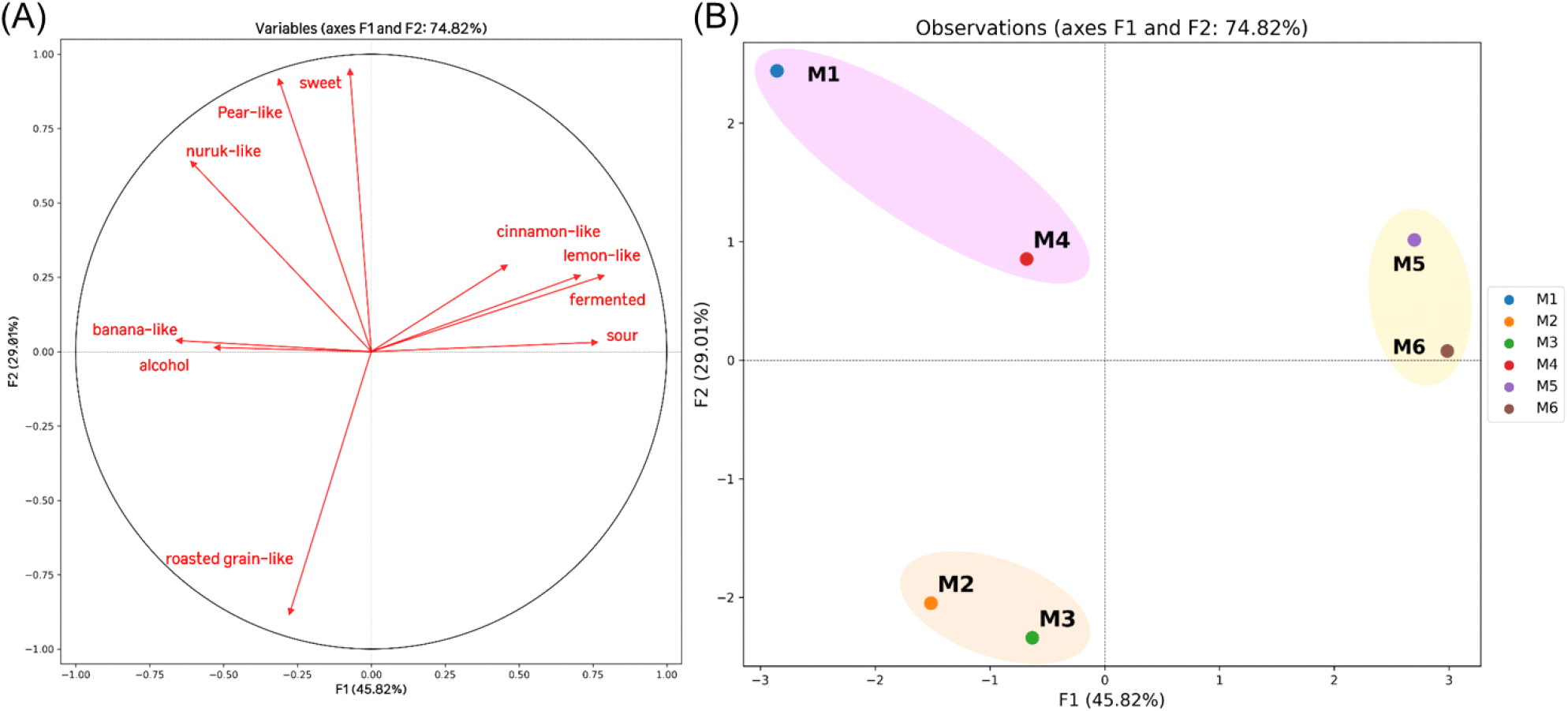1. 서론
막걸리는 쌀을 주원료로 하여 발효제와 효모를 이용해 발효시킨 한국의 전통주이다(Choi 등, 2012; Noh 등, 2022). 막걸리는 알코올 발효 과정에서 생성되는 다양한 성분들로 인해 복합적인 향미 특성을 가지며, 이러한 성분들은 소비자의 기호도와 제품의 품질을 결정하는 중요한 요소로 작용한다(Huh 등, 2012). 특히 발효 과정에서 생성되는 휘발성 향기 성분들은 막걸리의 관능적 특성을 형성하는 핵심 요소이며, 이들 성분의 조성과 함량은 원료, 발효제, 제조 방법 등 다양한 요인에 의해 영향을 받는다(Choi 등, 2020; Kwak 등, 2017; Woo 등, 2010; Yoon 등, 2024).
막걸리의 향기 성분은 크게 발효 과정에서 생성되는 알코올류, 에스테르류, 유기산류 등으로 구성 되며, 이들은 각각 특징적인 향기 특성을 나타낸다(Park 등, 2013). 그러나 이러한 성분들이 실제 인간의 후각으로 감지되는 정도는 단순히 성분의 함량만으로 예측하기 어렵다. 이는 각 성분마다 인간이 감지할 수 있는 최소 농도인 역치가 다르며, 성분들 간의 상호작용이 존재하기 때문이다(Hong 등, 2023).
주류에 존재하는 성분들의 향기 기여도를 평가하기 위해서 GC-olfactometry(GC-O), aroma extract dilution analysis (AEDA), odor activity values(OAVs) 등 다양한 방법이 활용되고 있다. GC-O는 기기 분석과 인간의 후각을 결합한 방법으로, 복잡한 매트릭스에서 향기 활성 물질을 선별하는 데 효과이다(Frank 등, 2001; Hofmann 등, 2018; Plutowska와 Wardencki, 2008). AEDA는 향 추출물을 순차적으로 희석하여 각 성분의 향기 강도를 평가하며, 도출된 향미 희석인자 계수(Flavor Dilution factor, FD factor)가 클수록 해당 성분이 기여하는 정도가 큰 것으로 잠재적으로 중요한 향기 성분을 스크리닝하는 데 사용되는 방법이다(Cheong, 2021; Grosch, 1993). 또한, 각 성분의 실제 농도를 해당 성분의 역치로 나눈 값인 OAVs를 통해 전체적인 향기에 대한 기여도를 평가할 수 있다(Chen 등, 2019; Wang 등, 2021).
이러한 분석법들을 통해 얻은 결과는 상호 보완적인 정보를 제공하며, 발효주의 향기 특성을 보다 포괄적으로 이해하는 데 도움을 준다. 최근 막걸리 시장이 다양화되고 소비자의 기호도가 세분화됨에 따라, 제품의 품질 특성을 결정하는 주요 향기 성분을 파악하고 이를 제어하는 것이 중요해지고 있다. 따라서 막걸리의 향기 특성을 정확히 이해하기 위해서는 기기분석을 통한 정량적 접근과 함께 인간의 감각을 통한 정성적 평가가 동시에 이루어져야 한다.
따라서 본 연구에서는 시판 생막걸리를 대상으로 향기 성분을 다각적으로 분석하고자 하였다. 구체적으로, GC-MS를 통한 휘발성 성분의 정량 분석, GC-O를 이용한 향기 활성 성분 분석, 그리고 정량적 묘사분석을 통한 관능적 특성 평가를 수행하였다. 또한, 각 성분의 OAVs를 산출하여 실제 향기 특성에 대한 기여도를 평가하고, 이들 결과를 종합적으로 분석하여 막걸리의 향기 특성을 결정하는 핵심 성분을 규명하고자 하였다. 이를 통해 막걸리의 품질 향상과 소비자별로 선호하는 특징의 제품 개발을 위한 기초 자료를 제공하고자 한다.
2. 재료 및 방법
본 연구에는 우리술 품평회 수상작이면서 생막걸리인 6종(M1-6)을 온라인에서 구매하여 분석에 사용하였으며, 이에 대한 정보를 Table S1에 나타냈다.
막걸리의 일반성분 분석은 국세청 주류 분석 규정을 따랐다(National Tax Service Liquors License Support Center, 2023). 알코올 함량은 메스실린더를 이용해 시료 100 mL를 취한 후 삼각플라스크에 옮기고 20 mL의 증류수로 2회 메스실린더에 남은 시료를 세척하여 삼각플라스크에 합병하였다. 삼각플라스크를 증류 및 냉각장치에 연결한 후 가열을 통해 증류액을 약 85 mL 이상 받고, 100 mL까지 증류수로 정용하였다. 증류액을 혼합하여 알코올 분석기(AL-3, Riken Keiki, Tokyo, Japan)를 이용하여 측정하였다. 가용성 고형분은 디지털 굴절계(PR-201, Atago Co., Tokyo, Japan)를 사용하여 측정하였으며, 환원당은 DNS법을 활용하였으며, Ultraviolet-visible spectrophotometer (Cary 3500, Agilent Technologies Co., Santa Clara, CA, USA)를 이용하여 550 nm 파장에서 흡광도를 측정하고, glucose(Sigma-Aldrich, St. Louis, MO, USA)를 표준물질로 검량곡선을 작성하여 환산하였다. 아스파탐 분석은 Choi 등(2011)의 연구에 제시된 전처리, 분석 방법을 일부 수정하여 진행하였다. 즉, 10분간 초음파 처리하여 시료에 존재하는 탄산가스를 제거하고, 60°C의 수욕상에서 15분간 가온하여 알코올을 증발시켰다. 이후 단백질 제거를 위해 Carrez 침전법을 활용하였고, 이 액을 원심분리하여 상등액을 0.22 μm 필터로 여과하여 분석에 이용하였다. 분석은 Hitachi LaChrom C18 column (5 μm, 4.6 mm I.D. × 250 mm, Hitachi High-Technologies Co., Tokyo, Japan)을 장착한 HPLC(LC-20A, Shimadzu Co., Kyoto, Japan)를 이용하였으며, 이동상은 CH3CN / 0.01 mol/L KH2PO4(pH3.18)=15/84(v/v), detector UV210 nm, flow rate 0.8 mL/min, injcetion volume 10 μL 조건으로 하였다. pH는 pH meter(Orion 3 Star Benchtop pH meter, Thermo Fisher Scientific Inc., Waltham, MA, USA)로 측정하였다. 총산은 시료 10 mL를 위하여 0.1 N NaOH(Yakuri pure chemicals Co., LTD, Kyoto, Japan) 용액으로 pH 7.0이 될 때까지 적정하여 그 값을 젖산으로 환산하여 나타냈다. 아미노산 함량은 시료 10 mL에 페놀프탈레인 지시약을 가하여 0.1 N NaOH 용액으로 엷은 분홍색이 나올 때까지 적정한 후 중성포르말린 용액(Yakuri pure chemicals Co., LTD) 5 mL 넣어 다시 0.1 N NaOH로 엷은 분홍색이 나올 때까지 적정한 값으로 나타냈다. 휘발산도는 증류한 시료 30 mL에 페놀프탈레인 지시약을 가하여 0.1 N NaOH 용액으로 엷은 분홍색이 나올 때까지 적정한 값으로 나타냈다.
본 연구에서는 시판 막걸리의 향미 특성을 확인하기 위하여, 원광대학교 생명윤리위원회의 승인을 받아 묘사분석을 수행하였다(IRB No. WKIRB-202304-HR-017). 묘사분석은 원광대학교 식품생명공학과에서 8명의 훈련된 패널에 의해 수행되었는데, 이들은 기본 맛과 향을 구별하고 강도의 차이를 평가할 수 있는지에 근거하여 1차 선발되었고, 선발 후 유사 표준물질을 이용하여 같은 특성을 가진 시료를 다른 특성을 가진 시료와 구분하는 훈련을 통하여 최종 선발되었다. 훈련된 패널들은 6종의 시판 막걸리에서 주요하게 감지되는 향미 특성을 묘사하고 그 표준물질들을 확립함으로써 묘사분석의 관능적 특성 용어를 표준화하였다. 묘사분석을 위한 각 막걸리는 뚜껑이 있는 투명한 컵에 20 mL씩 제공되었으며, 난수표에서 출력한 세 자리 숫자를 표기하여 Wiliam’s latin square법(Schlich 1993)에 의해 랜덤하게 제시하였다. 각 향미 특성의 강도는 15점 척도법를 사용하여 ‘매우 약함’을 1점, ‘매우 강함’을 15점으로 평가하도록 하였으며, 모든 분석은 3회 반복 수행되었다.
막걸리의 휘발 성분을 추출하기 위하여 Liquid-liquid continuous extraction(LLCE) 추출법을 사용하였다. 막걸리와 dichloromethane을 1:2 비율로 한 후 내부표준물질 2-ethyl-1-hexanol 1 mg/mL (w/v)를 혼합하여 30분간 300 rpm의 속도로 교반하여 용매를 추출하였다. 추출물을 여과지(Whatman No.41 filter paper, Whatman International LTD., Maidstone, England)를 사용하여 진공 하에 여과 후 유기용매 층 분리하여 무수황산나트륨으로 수분을 제거하였다. 수분을 제거한 추출 용매는 solvent-assisted flavor evaporation(SAFE)를 이용하여 휘발 성분을 추출하였다. 고진공 펌프(WSA Co., Ltd, Seoul, Korea)를 이용하여 3×10−5초 감압하여 휘발 성분 추출 후 vigrux distillation column(Vacuum Jacketed, 300 mm)을 사용하여 3 mL까지 농축시킨 후 질소가스로 0.1 mL까지 최종 부피를 측정하여 분석 시료로 사용하였다.
휘발 성분 분석은 Agilent 7890B GC(Agilent Technologies, Inc., Santa Clara, USA)와 극성도가 다른 DB-wax column(30 m × 0.25 μm I.D. × 0.25 μm film thickness, J&W scientific)와 HP-5MS column(30 m × 0.25 μm I.D. × 0.25 μm film thickness, Agilent)을 활용하여 수행하였다. DB-wax column을 이용한 분석 조건은 GC oven 온도는 초기 40°C에서 5분간 유지한 후, 5°C/min의 속도로 200°C까지 승온하여 20분간 유지하였다. HP-5MS column을 이용한 분석 조건은 초기 40°C에서 5분간 유지한 후, 3°C/min의 속도로 승온하였으며, 이후 5°C/min의 속도로 200°C까지 승온하여 10분간 유지하였다. 이동상 가스는 He으로 1 mL/min으로 설정하였으며, split 30:1 조건으로 2 μL 주입하였다. MSD-Olfactory Detection Port 3 (Agilent Technologies, Inc., Santa Clara, USA)(Gerstel, Mülheim an der Ruhr, Germany)는 detection temperature 250°C, inoinzation energy 70 eV, Mass scan range 33-350 a.m.u로 설정하였다. 휘발 성분 동정은 Retention Indices(RIs)와 NIST library(NIST 17)를 비교하여 수행하였다. 화합물의 RI값은 alkanes 표준물질(C7-C22)을 주입하여 측정하였다. 휘발 성분의 정량값은 총이온크로마토그램(TIC)에 기반한 면적을 내부표준물질(IS) 대비하여 계산되었다.
본 연구에서는 시판 막걸리의 향기 활성 성분을 확인하기 위하여, 원광대학교 생명윤리위원회의 승인을 받아 수행하였다(IRB No. WKIRB-202304-HR-017). 시판 막걸리의 향기 활성 성분은 가스크로마토그래피에 후각 시스템을 연결한 GC-O를 이용하여 추출한 시료에 포함된 성분들의 향 특성을 평가하였으며 감지된 향 특성을 정량화하여 향 활성 성분들의 상대적인 강도를 평가하기 위한 방법으로 가장 대중적으로 활용되고 있는 aroma extract dilution analysis(AEDA)를 실시하였다. 추출액에 재증류한 dichloromethane을 3배수로 단계적으로 희석하였고 희석액 2 μL를 주입한 후 sniffing port에서 감지되는 향 활성 성분의 retention time을 기록하였다. 위 과정을 냄새가 더 이상 나지 않을 때까지 행하여 향 희석계수(flavor dilutioin, FD)를 구하였다. Sniffing은 훈련받은 관능 요원 2명에 의해 행하였으며 여기서 얻어진 log3 FD 값을 평균하여 향 활성 성분의 상대적인 강도로 나타내었다.
막걸리의 각 향기 성분의 실제 기여도를 평가하기 위하여 각 향기 성분의 농도를 해당 성분의 odor threshold로 나누어 OAVs를 아래 식과 같이 산출하였다. 향기 성분의 역치는 기존 문헌을 참고하였다(Table S2).
본 연구에서는 python을 이용해 통계 분석을 수행하였으며, pandas, numpy, scipy로 데이터를 처리하고, matplotlib과 seaborn으로 시각화하였다. 향미 특성에 대해 주성분분석(principal component analysis, PCA)를 적용하여 시료간, 시료와 향미 특성간 관계를 분석하고 biplot으로 시각화하였다. GC-O, OAVs에서 도출된 주요 성분과 향미 특성 간 상관관계는 pearson 상관분석을 통해 평가하였으며, 상관계수의 절댓값이 0.6 이상인 경우를 강조하여 시각화하였다. GC-O와 OAVs 데이터는 log scale로 변환 후 bubble heatmap으로 시각화하였으며, 모든 분석은 p<0.05 수준에서 유의성을 평가하였다.
3. 결과 및 고찰
막걸리 6종에 대한 일반성분 분석 결과, 모든 분석 항목에서 시료 간에 유의적인 차이를 보였으며 이를 Table 1에 나타냈다. 막걸리에서 알코올은 발효 과정에서 효모에 의해 당이 전환된 결과로(Kim 등, 2022; Lee와 Park, 2010), 막걸리의 풍미와 보존성에 직접적인 영향을 미치므로 발효 정도를 알려주는 지표인 동시에 최종적인 제품에서는 소비자의 선택 요인으로 작용한다(Kwak 등, 2017). 막걸리 6종의 알코올 함량 분석 결과, M1과 M5가 다른 시료보다 높은 함량을 나타냈다. 막걸리 제조 시 사용된 원료의 분해 과정에서 생성되는 당, 유기산, 아미노산 등은 가용성 고형분에 포함되어 측정되며 막걸리의 감미와 농도감에 기여되는데(Kang 등, 2014), 막걸리 6종 중 M5가 가장 높게 나타났다. 또한, 발효 과정 중 완전히 소비되지 않고 남은 당분의 정도를 파악할 수 있는 환원당 또한 M5에서 가장 높게 나타나 해당 시료의 당이 가장 높게 잔존 하는 것을 알 수 있었다. 반면 생막걸리의 경우, 제품에 당이 남아있으면 유통 과정에서 알코올로 전환되며 의도치 않은 알코올 상승이 이루어질 수 있어 발효성 당이 아닌 아스파탐을 첨가하기도 한다(Park 등, 2011). 본 연구에서는 주로 환원당 함량이 5.9 g/100 mL 미만인 제품에서 아스파탐을 첨가하여 단맛을 보충하는 것으로 나타났다.
막걸리에서 단맛을 나타내는 당과 함께 신맛을 부여하는 산이 존재하여 조화를 이루며(Woo 등, 2010), 미생물 안정성에도 중요한 역할을 한다(Lee, 1968; Lee와 Lee, 2000). 막걸리 6종의 pH는 3.46-4.55, 총산은 0.2-0.82%로 나타났으며, 특히 M5와 M6이 산 함량이 높았다. 시료 중 M5와 M6은 생밀에 균을 자연 번식시켜 누룩을 제조하여 곰팡이뿐 아니라 효모와 유산균도 존재하기 때문에 효모를 추가적으로 첨가하지 않은 것으로 보인다(Kang 등, 2015b; Seo 등, 2005). 하지만 이로 인해 초기 효모가 우점하지 못하고 유산균이 생육하여 산 함량이 높게 나타난 것으로 파악된다(Choi 등, 2020).
또한, 원료로 사용되는 쌀과 밀에 포함된 단백질이 분해되며 아미노산이 생성되는데, 미생물의 영양원으로 이용됨과 동시에 감칠맛에도 영향을 주는 요인이다(Erasmus, 2005; Kang 등, 2015a). 이러한 아미노산 함량 또한 M5 시료에서 가장 높게 나타났다. 반면 발효 과정이나 저장 중에 생성되는 휘발산은 주로 초산으로 많은 양이 함유될 경우, 불쾌한 신맛을 초래하기 때문에 발효 관리와 저장 조건의 중요성을 나타내는 지표로 사용되기도 한다(Fleet, 1993; Jeong 등, 2013). 본 연구에서 휘발산 함량은 시료별로 차이가 크게 나타난 분석 항목으로 특히 M5와 M6이 다른 시료들에 비해 유의적으로 높은 수치를 보였다. 따라서 해당 시료들에서 초산균에 의한 발효가 진행되었을 가능성을 시사한다.
막걸리 6종을 정량적 묘사분석을 수행한 결과, 향 특성 8개(alcohol, banana-like, nuruk-like, pear-like, fermented, lemon-like, cinnamon-like, roasted grain-like)와 맛 특성 2개(sweet, sour)가 도출되었으며, 분석 시료 간 향미 특성에 유의적인 차이가 존재하였다. 묘사된 특성들의 용어 표준화와 이를 대표할 표준물질을 Table S3에 나타내고, 묘사분석을 통해 도출된 향미 특성에 대한 강도를 rader chart로 Fig. 1에 나타냈다.
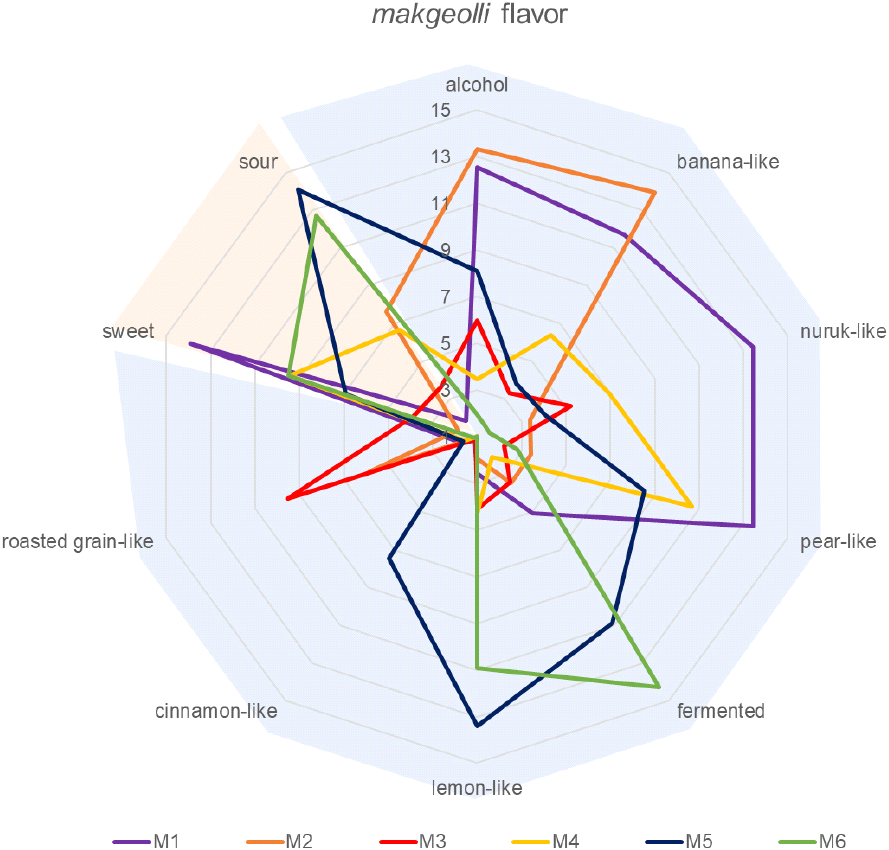
막걸리별로 향과 맛에 주요한 특성이 확인되었는데, M1은 sweet과 fruit flavor(pear-like, banana-like), nuruk-like가 특히 강하였으며, M2에서는 alcohol, banana-like 특성이 두드러졌다. M3는 roasted grain-like 특성이 특히 높게 평가되었으며, M4에서는 sweet, fruit flavor가 비교적 강하였다. 반면 M5에서는 cinnamon-like가 유일하게 평가되었고, sour, lemon-like가 다른 시료에 비해 강하였으며, M6에서는 fermented 특성이 특히 높게 평가되었다. 하지만 본 연구에서 사용한 막걸리 6종의 알코올 함량은 6.17-12.37%로 큰 차이를 보였으나, 향미 특성과 직접적인 연관성을 보이지 않았다. 이는 알코올 함량 조절 과정과 제조 방식에 기인한 것으로 판단된다. 일반적으로 막걸리는 발효 완료 시점에 알코올 함량이 15% 정도이나 제성 과정에서 물 첨가를 통해 알코올 함량이 조절된다. 이때 업체별로 상이한 제조 방법을 선택하는 것으로 보이는데, 일부 업체는 초기 담금 시 가수량 등을 조절하여 알코올뿐 아니라 다른 발효 산물의 농도도 함께 높게 유지하였으며, 다른 업체들은 제성 과정에서 감소하는 단맛을 보완하기 아스파탐을 첨가한 것으로 보인다. 또한, 실제 알코올 함량과 사람이 인식하는 알코올 강도에 차이를 보였는데, 특히 M2의 경우, 실제 알코올 함량(7.53%)이 높지 않음에도 alcohol 특성이 강하게 감지된 것은 환원당(1.18 g/100 mL)과 산도(0.20%)가 상대적으로 낮아 alcohol 특성이 더 부각된 것으로 해석된다. 반면 M5는 가장 높은 수준의 알코올(11.70%)을 함유하고 있음에도 높은 당도(12.08 g/100 mL)와 산도(0.85%)로 인해 alcohol 향이 상대적으로 약하게 평가된 것으로 보인다. 이는 막걸리의 향미 특성이 단순히 알코올 함량보다는 당, 산도 등 다른 성분들과의 복합적인 상호작용에 의해 결정됨을 시사한다.
막걸리와 감각 특성간, 시료와 감각 특성간의 상관성을 파악하기 위해 시료의 특성 강도에 대해 주성분 분석을 실시하였다(Fig. S1). 총 설명력 74.82%(제1 주성분=45.82%, 제2 주성분 =29.01%)로 나타났으며, 제1 주성분에 의해 M1, 2, 3, 4와 M5, 6이 대칭을 이루었으며 제2 주성분에 의해 M1, 4, 5, 6와 M2, 3이 대칭을 이루었다. 제1 주성분의 음의 방향으로는 banana-like, nuruk-like, alcohol, pear-like, roasted grain-like가 위치하였으며, 양의 방향에는 cinnamon-like, lemon-like, fermented, sour가 강하게 부하되었다. 또한, 제2 주성분은 제1 주성분 못지 않게 높은 설명력을 나타냈는데, 음의 방향으로 부하된 시료는 roasted grain-likr와 강한 상관성을 나타내었다.
이러한 시료간 향미 특성의 차이는 초기에 첨가한 발효제와 효모 등의 미생물이 중요한 역할을 한 것으로 나타났다(Han 등, 1997; Lee 등, 2012). 업체가 자가 제조한 재래누룩을 사용하며 효모를 첨가하지 않아 제조하고, 품질분석 결과 중 산이 높았던 M5와 M6은 fermented 특성과 lemon-like, sour가 강하게 부하되는 것을 알 수 있었다. 반면 동일하게 재래누룩을 사용하면서 효모를 첨가하지 않은 M1은 banana-like, pear-like와 같은 과일향이 높게 나타나고, sour는 적게 인지되어 M5, M6과는 분리된 것으로 나타났다. 이러한 차이로 봤을 때, 누룩을 자가 제조하여 특색있는 막걸리를 제조하는 것은 전통주 다양성 측면에서 좋은 방향이지만 과학적인 품질 평가를 통해 원하는 향미의 막걸리를 제조하기에 적합한 누룩을 제조하는 것이 중요할 것으로 판단된다.
막걸리에서 GC-MS를 통해 휘발 성분 43 성분이 검출되었으며 각 시료별 성분의 분포를 시각화하여 Fig. 2에 나타내었다. 모든 막걸리에서 ethyl acetate, 1-propanol, isobutanol, isoamyl alcohol, 3-ethoxypropanol, ethyl octanoate, acetic acid, 2,3-butanediol, ethyl decanoate, methionol, ethyl laurate, 2-phenylethanol, ethyl palmitate이 존재하였으며, 이 중 isoamyl alcohol, 2-phenylethanol, ethyl acetate, acetic acid, isobutanol이 주요한 성분으로 나타났다. 이들 화합물은 발효 과정에서 생성되며, 막걸리의 향기 프로파일을 형성하는 데 중요한 역할을 한다. Park 등(2014)에 따르면 isoamyl alcohol, 2-phenylethanol, ethyl-4-hydroxybutanoate, 2,3-butanediol가 막걸리에 주요한 성분으로 나타났으며, Jung 등(2014)에 따르면 2-phenylethanol, isoamyl alcohol, ethyl hexadecanoate, ethyl(Z)-octadec-9-enoate, ethyl-9,12-octadecadienoate이 막걸리 12종에서 높은 비율을 차지하는 것을 통해 alcohol류와 ester류가 막걸리에서 주요한 휘발 성분인 것을 확인할 수 있었다. 특히 이전 연구와 본 연구 모두에서 isoamyl alcohol은 막걸리에서 주요하게 검출되었으며, 높은 비율을 차지하여 전반적인 막걸리 향기에 크게 기여할 것으로 판단되었다. 다만 모든 막걸리에 일정 함량 포함된 성분이므로 유사한 함량으로 존재할 경우 시료간 차이를 구분하는 성분은 아닐 것으로 사료된다. 반면 시료별로 차이를 보이는 성분이 존재했는데, M1은 다른 시료보다 acetoin, 2,3-butanediol이 강하게 도출되었으며, propylen glycol, ethyl isobutyrate, acetol, 2-hydroxy-3-pentanone, ethyl nonanoate에 해당하는 성분이 다른 시료에서는 검출되지 않았지만 미량으로 나타났다. M2는 isoamyl acetate가 높게 검출되었으며, M5와 M6은 유사하게 다른 시료보다 ethyl lactate, acetic acid와 monoethyl succinate가 강하게 도출되는 것으로 나타났다.
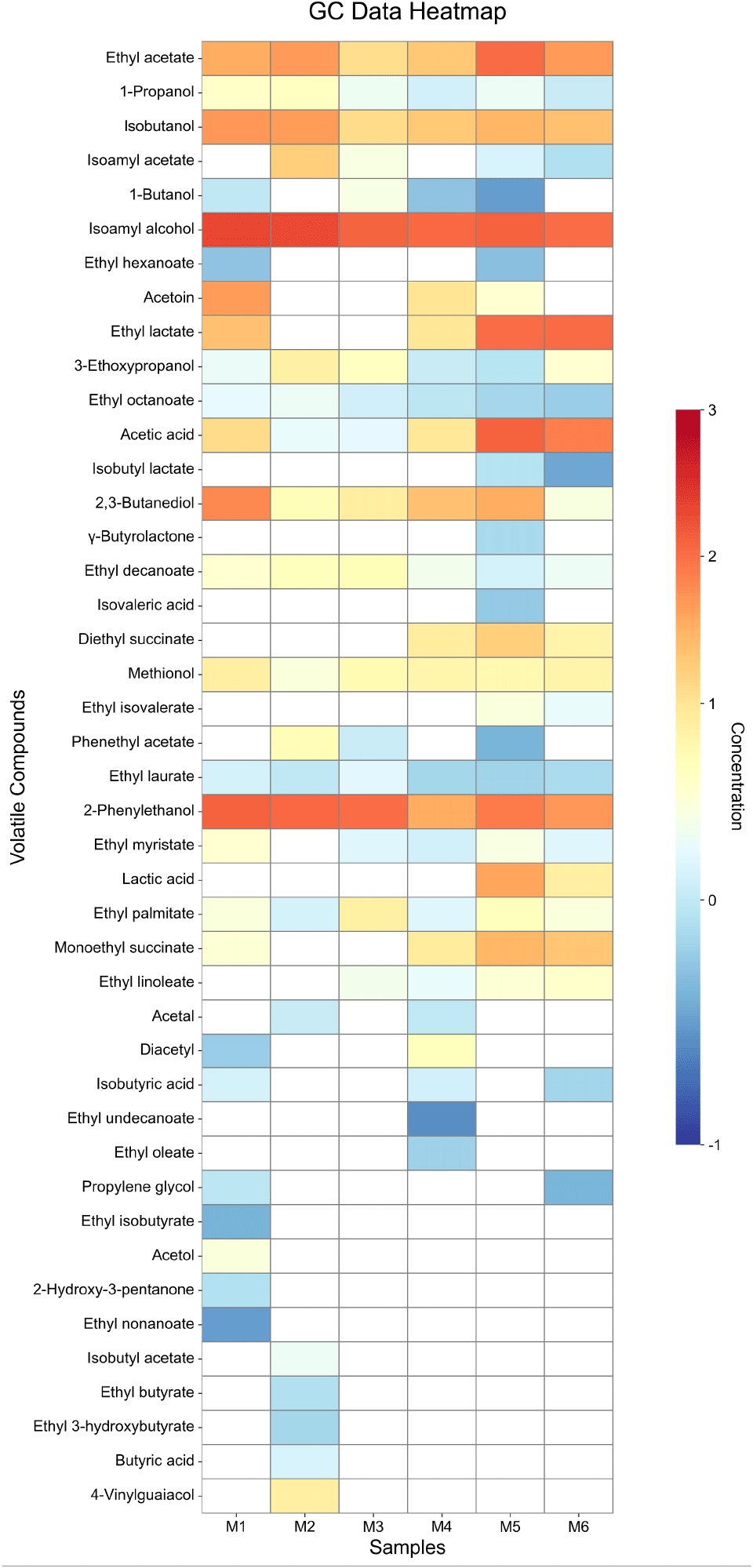
막걸리의 향기 활성 성분을 분석하기 위하여 GC-O를 이용하여 향 추출물 희석 분석(AEDA)한 결과를 Table 2에 나타냈다. 6가지 막걸리에서 총 38개의 odorants들이 확인되었으며, 여기에는 10개의 미동정 화합물(unknown)이 포함되었다. GC-O에서는 감지되었으나 GC-MS로는 분석이 되지 않은 미동정 화합물들의 경우, 감지된 향 특성이 인지된 각 컬럼의 상대적인 머무름지수(retention index)를 계산한 후 기존 데이터베이스와 선행문헌들을 참고하여 후배 물질들을 탐색한 후 이들의 authentic compounds의 positive analysis를 통하여 최종 확인하였으며, 총 15개의 미동정 화합물 중 5개의 화합물(ethyl propionate, ethyl isovalerate, ethyl valerate, methional, phenylethyl acetate)을 추가 확인하였다.
GC-O를 통하여 검출된 성분 중 isoamyl alcohol, ethyl lactate, acetic acid, methional, ethyl decanoate, diethyl succinate, methionol, 2-phenylethanol 8개 성분이 막걸리의 공통적인 성분으로 나타났으며, 전반적으로 FD factor가 높게 나타났다. 이들 중 methional을 제외하고 Jung 등(2014), Wong 등(2023)에서 조사한 대부분의 막걸리 휘발성 성분으로 검출된 바 있어 막걸리에서 주요하게 존재하는 성분으로 보이며, methional 또한 중국의 약주에 다량 존재하는 것으로 보고되어 쌀과 누룩을 이용한 주류에서 일반적으로 검출될 수 있는 성분으로 판단된다.
반면 막걸리 시료별 차이를 보이는 향기 활성 성분이 존재하였다. M1은 banana, fermented와 관련된 unknown4과 roasted lamond, potato-like를 나타내는 methional이 두드러졌으며, 특히 sweet 특성을 나타내는 1-butanol과 makgeolli 특성의 unknown3는 다른 시료에서는 발견되지 않았다. M2에서는 ethyl decanoate가 다른 시료 대비 3배(FD factor 1) 이상의 활성을 보였고, sweet 특성의 ethyl hexanoate, floral 특성의 unknown8과 grain 특성의 4-vinylguaiacol, unknown9이 유일하게 검출되었다. M3의 경우 전반적으로 낮은 FD factor를 보였으나 burnt sugar 특성의 γ-Nonalactone, cotton candy 특성의 unknown10이 상대적으로 높게 나타났으며, slight fermented 특성의 isoamyl acetate, moldy 특성의 unknown5, potato 특성의 1,3-propanediol diacetate, nutty 특성인 ethyl laurate가 특이적으로 검출됐다. 반면 fruity 특성의 ethyl propionate, sweet 특성의 2,3-butanediol, isobutyric acid는 다른 모든 시료에서 검출되었으나 M3에서만 나타나지 않았다. 모든 시료에서 공통적으로 cheese 특성의 diethyl succinate, rose 특성의 2-phenylethanol이 높게 나타났지만 M4에서 가장 높게 인지되었으며, 다른 막걸리에서는 주로 인지되지 않은 diacetyl, ethylphenyl acetate가 강하게 나타났다. M5와 M6은 ethyl propionate, acetic acid, 2,3-butanediol과 같은 유사한 성분이 강하게 발현되었으며, 개별적으로 M5에서는 floral 특성의 unknown2와 fruity 특성의 ethyl valerate, M6에서는 creamy 특성의 unknown1과 fruity 특성의 ethyl isovalerate, peppermint 특성의 isoprenol이 특이적으로 검출되었다.
휘발 성분마다 사람에게 인지될 수 있는 최저 농도가 다르기 때문에 단순하게 정량값만으로 해당 성분이 막걸리 전반적인 향에 미치는 영향을 파악하기는 어렵다(Wu 등, 2024). 따라서 각 성분의 정량값 대비 인지되는 최저 농도인 역치값으로 나눈 OAVs를 이용하며, 일반적으로 OAVs가 1보다 큰 성분은 전체의 향에 영향을 미칠 가능성이 높다고 판단한다(Osafune 등, 2020). 막걸리에서 검출된 성분의 OAVs 분석 결과를 시각화하여 Fig. 3에 나타내었으며, ethyl acetate, isobutanol, isoamyl alcohol, ethyl octanoate, 2,3-butanediol, ethyl decanoate, methionol, 2-phenylethanol이 모든 막걸리에서 OAVs 1 이상으로 나타났다. 또한 ethyl decanoate, 2-phenylethanol, 2,3-butanediol은 OAVs가 다른 성분보다 높아 막걸리의 주요한 기본 향기 성분으로 판단되었다. 반면 시료별로 강하게 나타나는 성분들이 존재하였는데, M1 시료에서는 lactic acid, acetoin, 2,3-butanediol이 강하게 발현되었으며 M2는 유일하게 isobutyl acetate, ethyl butyrate, butyric acid, 4-vinylguaiacol이 도출되었으며 이들의 OAVs가 1 이상의 값을 갖는 것으로 나타나 M2의 독특한 향을 나타내는 성분으로 추측되었다. M4 시료는 diacetyl, ethyl undecanoate가 다른 시료보다 강하게 나타났으며 M5와 M6은 ethyl isovalerate가 강하게 나타나는 것으로 보였다. 하지만 M3의 경우, 다른 시료보다 강하게 발현되는 성분이 크게 없이 대부분의 막걸리에서 공통적으로 OAVs가 1 이상인 성분들로 구성된 것으로 보였다.
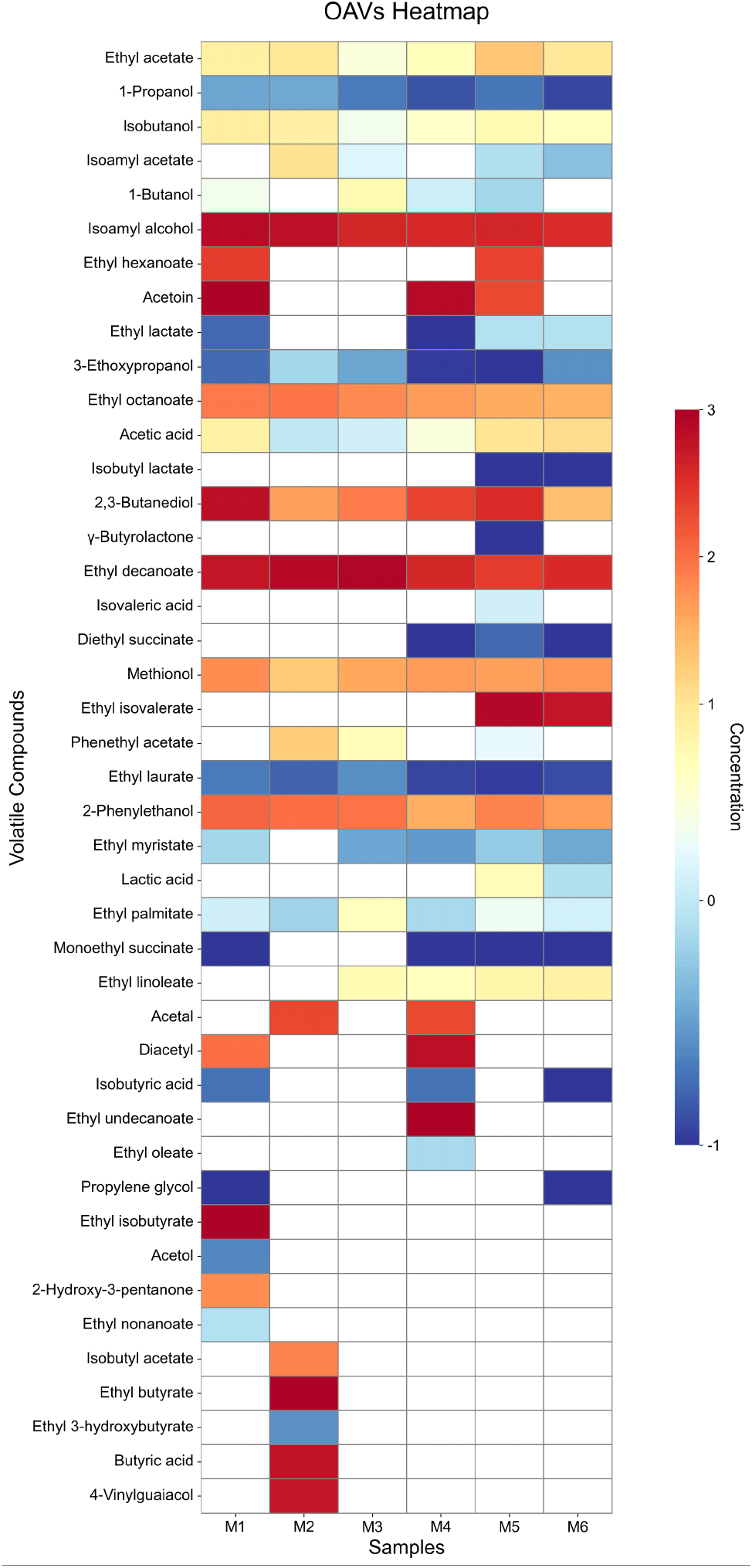
본 연구에서는 6종의 막걸리를 대상으로 향미 특성 도출, GC, GC-O 분석 및 OAVs를 산출하였고, 각 분석별로 향미 특성에 주요하게 영향을 미칠 수 있는 성분을 종합적으로 파악하고자 하였다. 각 시료별로 주요하게 나타난 성분 중 GC-O FD factor, OAVs가 높은 순서대로 5개씩을 선정하여 Table 3, Table S4와 Fig. 4에 나타내고, 성분들과 향미 특성과의 관계성을 시각화하여 Fig. 5에 나타냈다.
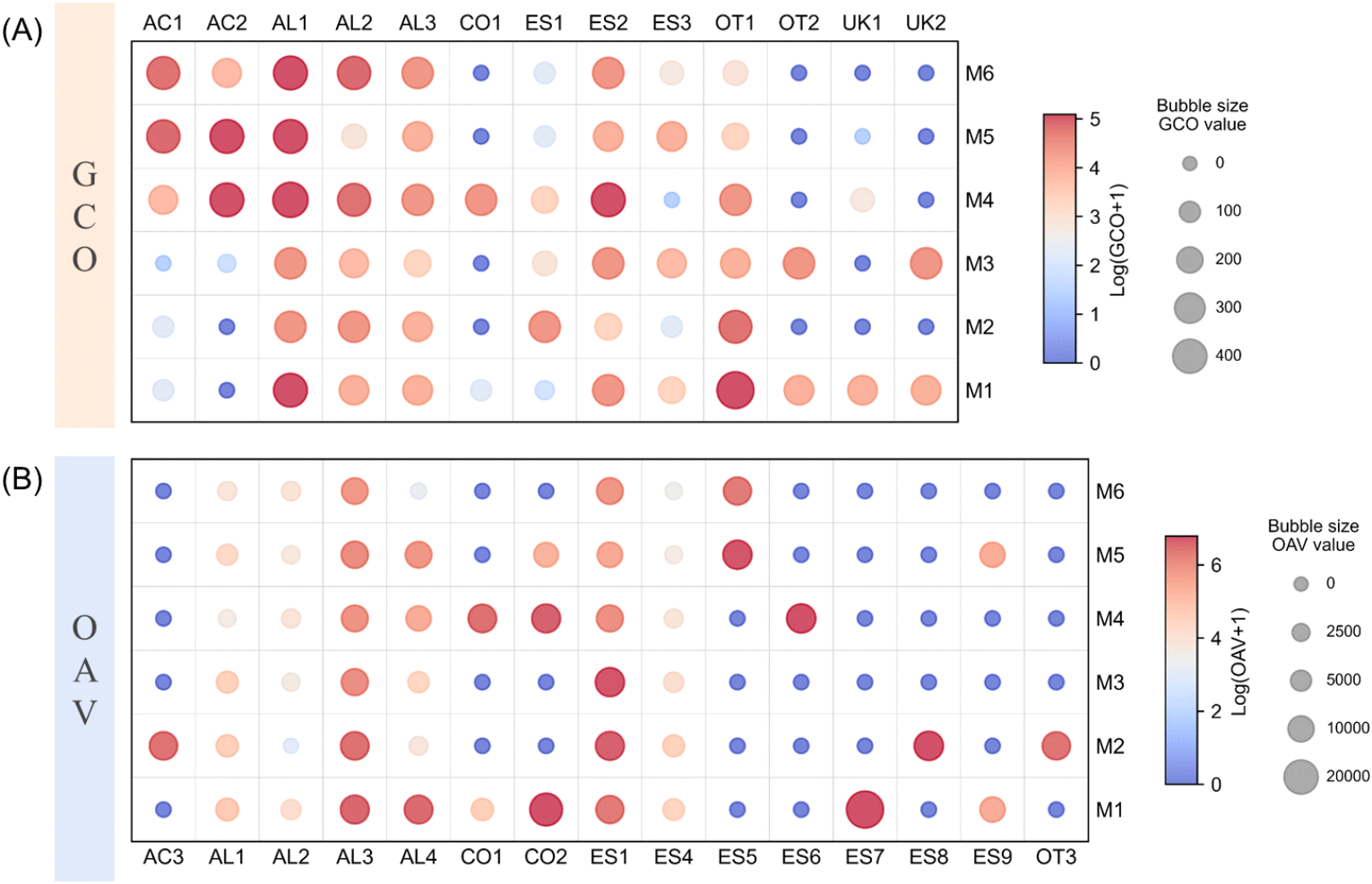
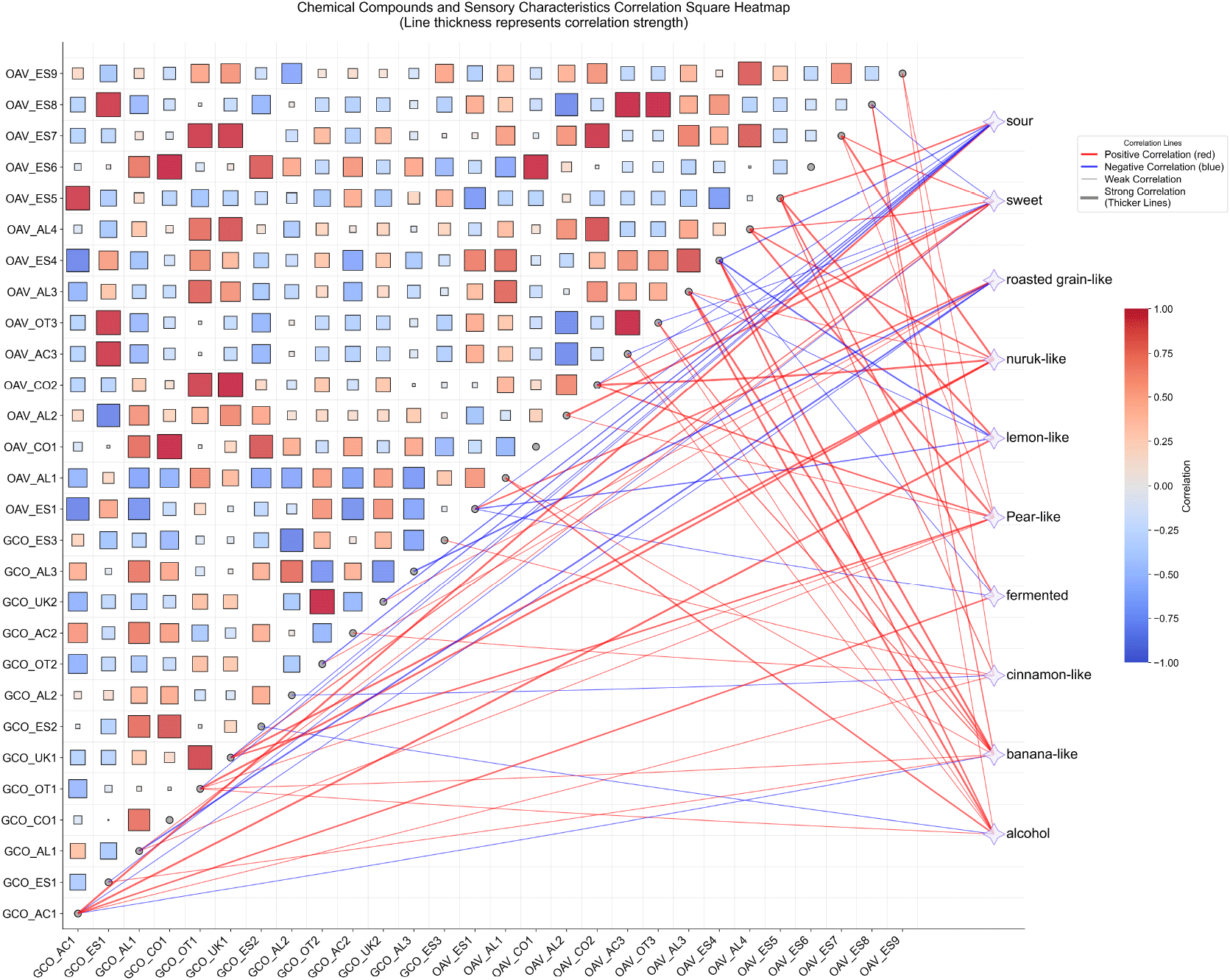
GC-O 분석 결과, 2-phenylethanol이 전반적으로 높은 FD factor(4.0-5.0)를 보였으며, methional과 diethyl succinate도 높게 나타났다. OAVs에서는 2-phenylethanol(34-116), methionol (20-60), isoamyl alcohol(345-730), 2,3-butanediol(24-685)이 모든 시료에서 일정 수준 이상으로 검출되어 막걸리의 기본 향 프로필을 형성하는 핵심 성분으로 확인되었다. 특히 ethyl isobutyrate는 M1 시료에서 20,203의 매우 높은 OAVs를 나타내었다.
한편, 일부 성분들은 두 분석법 간 결과의 불일치를 보였다. Ethyl lactate은 GC-O에서만 높은 FD factor를 나타냈으며, 4-vinylguaiacol, butyric acid, acetoin, diacetyl, γ-nonalactone은 OAVs에서만 높은 값을 나타냈다. Lee와 Park(2013)에 따르면 GC-O는 인간의 후각을 통한 직접적인 평가 방법으로 실제 관능적 특성을 반영할 수 있는 장점이 있으나, 패널의 민감도와 피로도에 따라 결과가 달라질 수 있다. 반면 OAVs는 정량적 접근이 가능하나 대부분의 역치값이 물이나 에탄올 수용액에서 측정되어 실제 발효주의 복잡한 매트릭스에서는 차이를 보일 수 있다는 한계가 있다. 또한, 향기 성분 추출 전처리 방법, GC 컬럼 종류 등 다양한 분석 변수들이 특정 화합물 군의 분리능과 검출 감도에 영향을 미칠 수 있다(Liu 등, 2022; Ma 등, 2012; Marin-San Roman 등, 2022). 이러한 요인들로 인해 본 연구에서도 검출되는 성분이 선택적으로 검출 감도 차이가 발생할 수 있으며, 분석법별 다른 결과의 차이를 보인 것으로 판단된다.
또한, 모든 시료에서 검출된 성분들과 향미 특성 간의 상관관계 분석에서 주목할 만한 결과들이 도출되었다. Isoamyl alcohol은 alcohol(r=0.934)과 banana-like(r=0.907) 향과 강한 양의 상관관계를 나타냈으며, Hong 등(2012)의 연구에서도 isoamyl alcohol이 바나나향의 전구체로서 중요한 역할을 한다고 보고된 바 있다. Methional은 nuruk-like 향(r=0.908)과 강한 양의 상관관계를 보여 막걸리의 특징적인 누룩향 형성에 핵심적인 역할을 하는 것으로 나타났다. 2,3-Butanediol의 경우, OAVs에서만 주요한 성분으로 도출되었지만 pear-like(r=0.903)와 nuruk-like(r=0.884) 향과 강한 양의 상관관계를 보여, 2,3-butanediol이 막걸리의 과일향과 발효취 형성에 동시에 기여함을 시사한다.
더불어, 개별 성분의 특징적인 향과 실제 인지되는 향미 특성 간에도 차이가 관찰되었다. 특히 주목할 만한 점은 2-phenylethanol의 경우로, GC-O와 OAV 분석 모두에서 높은 값을 보였고 GC-O 분석에서 floral, rose 향(FD factor 4.0-5.0)으로 동정되었으나, 실제 막걸리의 향미 특성에서는 이러한 장미향이 뚜렷하게 감지되지 않았다. Chen 등(2019)의 연구에서도 발효주의 복잡한 매트릭스에서는 이러한 차이가 발생할 수 있음을 지적한 바 있다. 이는 발효주의 복잡한 매트릭스 효과와 다른 향기 성분들과의 상호작용으로 인한 마스킹 효과 때문으로 해석된다.
이러한 결과는 막걸리 내에서 각 성분의 역치값을 도출하여 정확한 OAVs를 도출할 필요가 있으며, 막걸리 내의 향기 성분은 단일 분석법만으로 완전한 프로파일을 확인하기 어려우므로 각 분석법이 가진 한계점을 상호 보완하는 다각적 접근이 필요함을 시사한다. 따라서 향후 제품 개발 및 품질 관리를 위한 지표 성분 선정 시에는 여러 분석법의 결과를 종합적으로 고려하여 평가하는 것이 바람직할 것으로 판단된다.
4. 요약
본 연구는 막걸리의 주요 향기 성분을 식별하고, 이들 성분이 막걸리의 향기 프로파일에 기여하는 정도를 파악하고자 하였다. 이를 위해 시판 생막걸리 6종을 대상으로 다각적인 분석을 실시하였다. 정량적 묘사분석을 통해 10개의 주요 향미 특성이 도출되었으며, 특히 재래누룩을 사용한 시료들 간에도 향미 특성의 차이가 뚜렷하게 나타났다. 자가 제조 재래누룩을 사용한 시료들(M5, M6)은 발효취와 산 함량이 높은 반면, M1의 경우 과일향이 우세하게 나타나 누룩의 제조 방식이 막걸리의 향미 특성에 중요한 영향을 미치는 것으로 판단되었다. GC-MS 분석으로 43개의 휘발 성분이 검출되었고, GC-O 분석을 통해 38개의 향기 활성 성분이 확인되었으며, 특히 acetic acid, isoamyl alcohol, methionol, 2-phenylethanol등 8개 성분이 모든 시료의 주요 향기 성분으로 나타났다. OAVs 산출 결과와 종합적으로 볼 때, 2-phenylethanol, methionol, isoamyl alcohol, ethyl caprate가 막걸리의 기본 향 프로파일을 형성하는 성분으로 확인되었다. 상관관계 분석 결과, isoamyl alcohol은 알코올향(r=0.934)과 바나나향(r=0.907)에, methional은 누룩향(r= 0.908)에 강하게 기여하는 것으로 나타났다. 주목할 점은 장미향으로 인지되는 phenylethanol이 GC-O와 OAVs 모두에서 높은 값을 보였으나 실제 막걸리에서는 이러한 특성이 뚜렷하게 감지되지 않았는데, 이는 막걸리의 복잡한 매트릭스 효과와 다른 향기 성분들과의 상호작용으로 인한 마스킹 효과로 해석된다. 또한 일부 성분들은 GC-O와 OAVs 분석 간 결과의 불일치를 보였는데, 이는 각 분석법이 가진 한계점에 기인한 것으로 판단된다. 이러한 결과는 막걸리의 향기 성분 분석 시 단일 분석법만으로는 완전한 프로파일을 확인하기 어려우므로, 향후 제품 개발 및 품질 관리를 위한 지표 성분 선정 시에는 여러 분석이 종합적으로 고려하여 평가하는 것이 바람직함을 시사한다. 본 연구에서 도출된 막걸리 주요 향기 성분에 기여하는 성분들에 대한 정보는 막걸리의 품질 향상과 소비자 선호도를 고려한 제품 개발의 기초 자료로 활용될 수 있을 것으로 기대된다.

